Air purifiers
Air purifiers, fans, humidifiers, and heaters engineered for comfort and designed to reduce your exposure to allergens for a healthier home.*


Dyson’s most powerful and quiet compact purifier
Frequently asked questions
Yes, air purifiers can be effective in improving indoor air quality by removing harmful particles and pollutants from the air.
Air purifiers work by using a combination of filters and technologies, such as HEPA (High Efficiency Particulate Air) filters, activated carbon, and other technologies to capture and eliminate airborne particles, such as dust, allergens, mold spores, pet dander, and even bacteria and viruses. ¹⁰
Yes, air purifiers can help with dust by capturing and removing airborne particles from the air.
Dust and other small particles may contribute to respiratory problems and allergies. High Efficiency Particulate Air (HEPA) filters are especially effective at capturing tiny particles like dust, pollen, and pet dander. ¹⁰
Whether an air purifier is worth it or not depends on your specific needs and circumstances.
Air purifiers can be beneficial for people who want to improve indoor air quality in general. They can help to remove harmful particles and pollutants from the air, including dust, allergens, pet dander, and some are proven to filter bacteria, viruses, and mold spores. ¹⁰
An air purifier is a device that cleans the air in a room or a building by removing potentially harmful particles and pollutants, such as dust, pollen, pet dander, and other airborne contaminants. ¹⁰
It works by drawing air through a filter, which traps these particles and releases cleaner air back into the room.
Some of the benefits of using an air purifier include:
- Improved indoor air quality: An air purifier can remove harmful particles and pollutants from the air, leading to cleaner air indoors.
- Reduced odors: Some air purifiers can help to remove unpleasant odors from the air, such as those caused by cooking, pets, or smoking.
Yes, air purifiers can help to remove allergens* such as pollen, dust, and pet dander from the air.
Air purifiers work by drawing in air and passing it through a filter, which traps pollutants and allergens.* Some air purifiers are specifically designed with HEPA (High-Efficiency Particulate Air) filters, which have a high removal percentage for very small particles, including many common allergens.*
Studies have shown that using an air purifier with a HEPA filter can help to reduce the concentration of airborne allergens* in indoor spaces.
Some air purifiers can help with removing unpleasant odors and smells from the air.
Certain air purifiers are equipped gas-capture technologies such as activated carbon filters. Activated carbon absorbs and remove certain odors, gases, and chemical fumes from the air.
Activated carbon filters contain a porous material, such as activated charcoal, which traps and eliminates odors and volatile organic compounds (VOCs).
To get the most out of an air purifier, it's important to place it in the right location.
If you're using an air purifier to address a specific source of pollution, such as smoke from a fireplace or cooking fumes, it's best to place the air purifier as close to the source as possible to capture the pollutants before they spread.
For general air cleaning, place the air purifier in the center of the room, away from walls or furniture, to allow for maximum airflow and coverage.
An air purifier is not designed to directly help with humidity levels in the air.
An air purifier is not a substitute for a humidifier or dehumidifier if you are looking to control humidity levels in your home or office.
Yes, air purifiers can be effective in reducing the impact of wildfire smoke on indoor air quality. Wildfire smoke contains a variety of harmful pollutants, including fine particles (PM2.5), volatile organic compounds (VOCs), and other potentially toxic substances. Air purifiers with high-efficiency particulate air (HEPA) filters can effectively capture and remove these particles from the air.
Air purifiers with HEPA filters can be effective at removing many wildfire smoke particles from indoor air. Additionally, activated carbon filters, often included in air purifiers, can help reduce the levels of VOCs and odors associated with wildfire smoke.
When using an air purifier for wildfire smoke, it's important to choose a model with appropriate coverage for your room size and ensure that the device runs continuously in the affected areas. Keeping doors and windows closed also helps prevent outdoor smoke from infiltrating the indoor environment.
It's worth noting that while air purifiers can help to improve indoor air quality during wildfires, they may not eliminate all pollutants. Factors such as the proximity of the wildfire, the intensity of the smoke, and the overall ventilation in your home can affect the effectiveness of air purifiers. In severe cases, it may be advisable to seek additional measures or temporary relocation if the air quality poses a serious health risk.


Get more with the MyDyson™ app▴
Discover what you get with the app.
-
Expert guides
Learn how to improve your indoor environment.
-
Exclusive offers
Gain access to exclusive offers through the app.
-
24/7 support
Machine performance updates.
-
2 or 5 Year Limited Warranty
On parts, repairs and replacements.
-
-
*Allergens refer to non-living material.
'++Electrostatic filter life tested to GB/T 18801-2022 to a 50% decline in CADR, based on 12 hours use per day. Filter life varies according to pollution levels.
⁰Filtration efficiency to IEST -RP-CC001.7. Gas capture rates may vary.
▴The MyDyson™ app is only compatible with select Dyson products. For a list of compatible products, please click here.
**Dyson offers a range of advanced purifiers that remove gases and odors and capture 99.97% of allergens* and pollutants 0.3 microns in size.
⁸Tested in maximum setting for air projection, tested in Auto mode for purification coverage, tested for room heating per relevant Dyson method DTM961.
⁹Particle challenge by DEHS oil specified in EN1822 within a chamber specified in ASTM F3150.
¹⁰Not intended as a product claim. Refer to individual Dyson models for specific capture claims.








